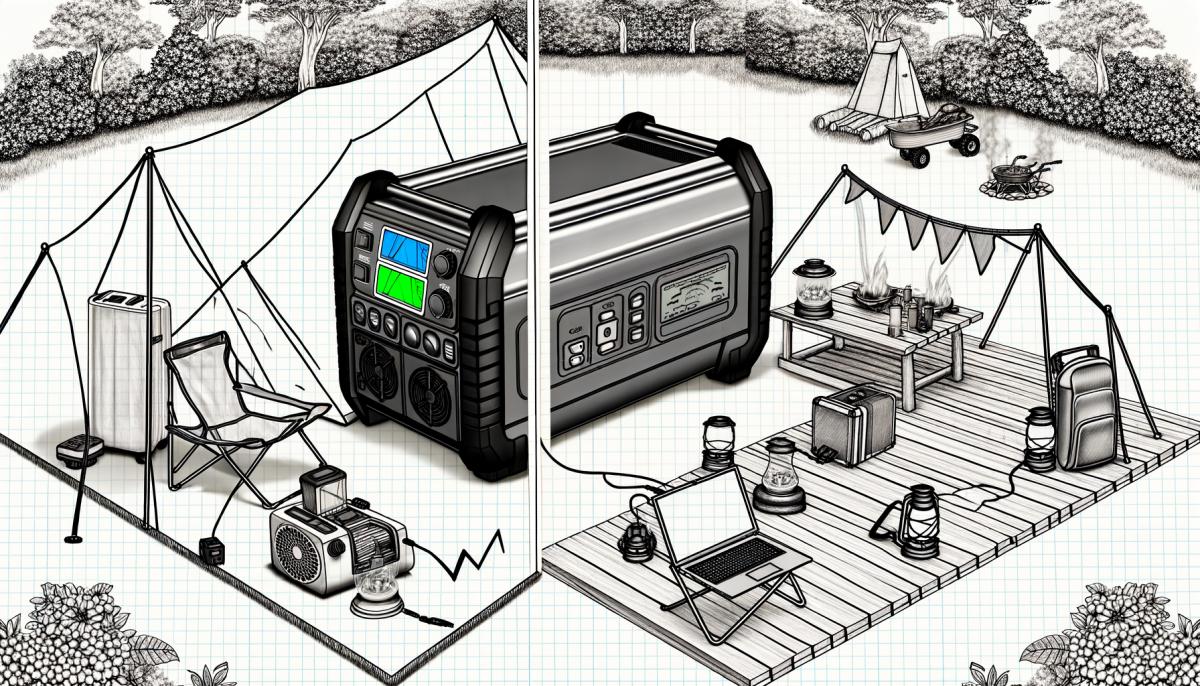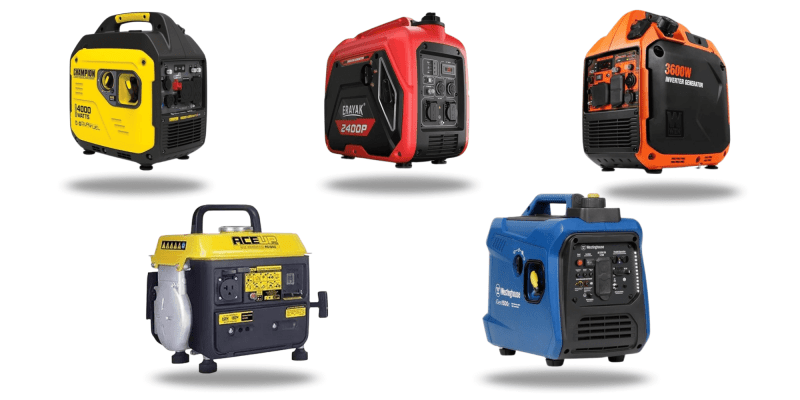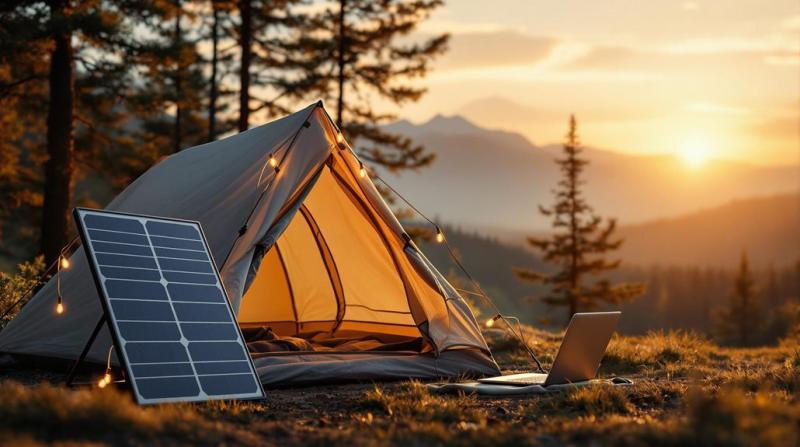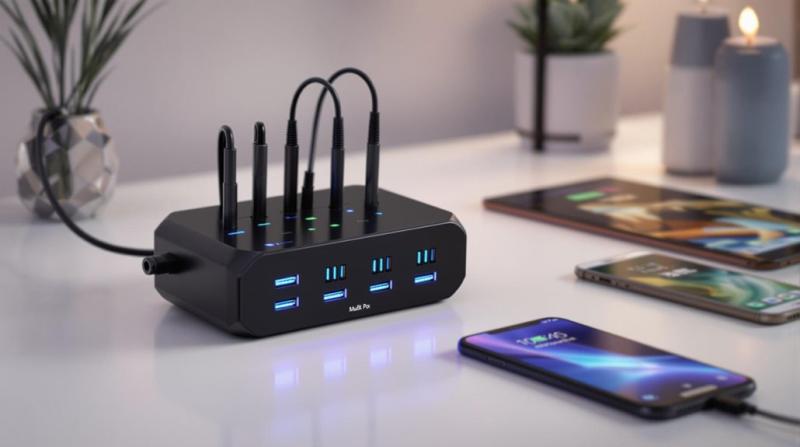When you're picking out portable power stations, the first thing to think about is the battery capacity and the technology behind it. Check out the watt-hour ratings—higher numbers mean you can use your devices for longer. For example, a 500Wh unit can keep a 100-watt device running for about five hours. Isn't that cool?
Lithium-ion batteries are generally the way to go. They give you the best performance and last a long time, sometimes up to 2,000 cycles. That's pretty impressive, right?
And don't forget about inverter efficiency. You can lose 10-20% of energy there, which can definitely make a difference in how long you can use your power station.
Another thing to think about is the build quality and how well the station manages heat. Good thermal management can make your power station last longer. So, it's worth checking out.
And hey, you'll want to find a good balance between portability and battery life based on what you need. Looking into all these aspects will really help you make a smart choice.
Understanding Battery Capacity
When you're picking out a portable power station, getting a handle on battery capacity is super important. It directly affects how long your gadgets will keep running before you need to plug them back in.
Usually, battery capacity is measured in watt-hours (Wh). This basically tells you how much total energy the battery can store and dish out. So, if a power station boasts a 500 Wh capacity, it could theoretically keep a 100-watt device running for five hours. Pretty handy, right?
Now, to really get a good read on battery capacity, you've got to think about the types of devices you plan on charging. Different gadgets gobble up different amounts of power. For example, a smartphone might only need 10-20 watts, but a laptop? That could demand anywhere from 50 to 100 watts.
So, when you're figuring out how long you can keep your stuff powered up, it's crucial to consider their specific power needs in relation to your power station's capacity.
Oh, and don't forget about the efficiency of the power inverter inside the station. Most portable power stations come with an inverter that changes DC power from the battery into AC power for your devices. This switcheroo isn't 100% efficient; you could lose around 10-20% of the energy in the process.
So, when you're estimating how much juice you'll need, it's smart to factor in this inefficiency.
In the end, understanding battery capacity helps you make smart choices, ensuring you pick a portable power station that can reliably meet your needs. And let's be honest, who doesn't want to make their mobile life a bit easier?
Key Features for Longevity
To make sure your portable power station stands the test of time, you really need to look for key features that boost durability and reliability.
First off, think about the build quality. Power stations made from tough materials like ABS plastic or aluminum handle impacts and weather better. This makes them perfect for outdoor adventures.
Next up, let's talk about thermal management. Efficient cooling systems are a must to keep your power station from overheating, especially when you're using it a lot. Look for models with fans or heat dissipation designs that keep the internal temperatures in check.
And don't forget about Battery Management Systems (BMS). A good BMS ensures your power station charges and discharges at its best, protects against overcharging, and balances cell performance. All these things together make your power station last longer. Check for models with features like short-circuit, surge, and over-current protection.
Another cool thing to look for is a modular design. If your power station has parts that you can easily remove and replace, you can upgrade or fix it without much hassle. This can really extend its life and keep it running smoothly.
Lastly, think about the warranty and customer support. A solid warranty shows that the manufacturer believes in their product's durability. Plus, having good customer support means you have someone to turn to if things go wrong. That's a nice bit of extra peace of mind for your investment.
Types of Battery Technologies
Understanding the different types of battery technologies is super important for getting the best performance and longevity from your portable power station. The most common ones you'll come across are lithium-ion, lead-acid, and lithium iron phosphate (LiFePO4). Each type has its own unique characteristics that can affect efficiency and lifespan.
So, let's start with lithium-ion batteries. They're pretty much the big players in the market because of their high energy density and lightweight build. These batteries can discharge at a higher rate, which makes them perfect for all sorts of stuff—from powering tools to charging your phone. Usually, they last between 500 to 2,000 cycles if you take good care of them. Just be mindful of the temperature; too much heat can really mess with their performance.
Then, we've lead-acid batteries. Sure, they're cheaper and quite robust, but they come with some downsides. They're heavier and don't have as high an energy density as lithium-ion batteries. Their cycle life ranges from 200 to 1,000 cycles, depending on how you maintain them and how often you discharge them. If you're looking for a budget-friendly option for less demanding tasks, lead-acid could be a good fit. Just don't expect them to last as long.
Finally, let's talk about lithium iron phosphate (LiFePO4) batteries. These are becoming more popular because of their enhanced safety and stability. They can last up to 4,000 cycles and have better thermal stability compared to regular lithium-ion batteries. They might be a bit pricier, but it's an investment that can pay off if you need reliable power for a long time.
Evaluating Watt-Hour Ratings
Alright, so when you're looking at watt-hour ratings, you've gotta get the basics down about how this measurement shows a power station's capacity.
It's kinda like figuring out how much juice each model can hold and dish out.
You'll wanna compare the watt-hour ratings of different models to see which one can keep up with your energy needs when you're using it.
Knowing these basics will totally help you pick the right portable power solution for what you need.
Understanding Watt-Hour Basics
Understanding Watt-Hour Basics
So, let's talk about watt-hour ratings. They're super important for figuring out how long a portable power station can keep your devices running smoothly.
Basically, a watt-hour (Wh) tells you how much energy a battery can store. To get this, you need to know about voltage (V), current (A), and capacity (Wh). It's really not that complicated. Just multiply the voltage by the amp-hours (Ah) and boom, you've got watt-hours.
For instance, imagine you've got a power station with a 12V output and a capacity of 100Ah. You'd calculate the watt-hours like this: 12V × 100Ah = 1200Wh. This means, in theory, your station can give you 1200 watts for one hour or 600 watts for two hours. Pretty neat, right? It gives you a much clearer idea of how long you can use your gadgets.
But wait, there's more! You have to think about the efficiency of the inverter too. It's usually between 80% to 90%, and this affects the actual usable watt-hours.
And don't forget to check your devices' power needs. Knowing how watt-hours work helps you pick the perfect portable power station for your adventures or emergencies.
Comparing Battery Capacities
When you start comparing the watt-hour ratings of different portable power stations, you'll notice some pretty big differences in battery capacities. These differences can really affect how long you can use your devices. Watt-hours, or Wh for short, measure a power station's energy storage, basically telling you how long it can keep your gadgets running. Higher watt-hour ratings mean your power station will last longer, which is super important for those long trips or emergencies.
So, when you're looking at different models, think about what you need. For example, charging a small device like a phone might only take 10-20 Wh. But if you're powering bigger stuff like laptops or CPAP machines, you could need 50-200 Wh or even more. Knowing what your devices need helps you pick a power station that fits your usage.
But hey, don't forget, power stations with higher watt-hour ratings can be heavier and bulkier. So, you've got to balance capacity and portability. Also, check if the power station has extra ports and inverter capabilities, because these features can really make a difference in your experience.
In the end, picking the right portable power station is all about matching your power needs to the watt-hour capacities available. Make sure you choose one that fits your specific applications and lifestyle.
Portability Vs. Battery Life
Balancing portability and battery life is a big deal when you're trying to get the most out of your power station, whether you're out on an adventure or dealing with an emergency.
Lightweight units with compact designs are a dream for portability, no doubt. They're easier to carry around and store. But, there's always a catch, right? Smaller power stations usually mean smaller batteries, so they mightn't keep your devices going for as long as you'd like.
So, when you're looking at different options, think about the weight and size compared to what you actually need. Sure, a power station that weighs under 20 pounds sounds perfect for a hike. But if it can't keep your essential gear running, you might end up in a bit of a pickle. Really think about your typical usage—how long do you need your devices to stay powered?
Now, a bigger power station might be a bit of a hassle to lug around, but it could give you the battery life you need for those longer trips. It's all about what you prioritize. If you need quick energy on the move, a lighter unit could be your best bet. But if you're going to be in one spot for a while, a model with a stronger battery might make more sense.
And don't forget about charging times and input options. Some models have fast-charging features that can make up for a bigger battery. At the end of the day, finding the right balance is all about understanding what you really need. Do you care more about weight and easy transport? Or is it more about keeping your devices charged for longer stretches?
Real-World Usage Scenarios
When you're thinking about portable power stations, it's super important to consider how they'll perform in real-life situations, like when you go camping or need to prepare for emergencies.
Understanding what kind of power you'll need in these scenarios can really help you pick the right model.
Camping Essentials and Needs
Portable power stations are a game-changer for campers who need electricity for stuff like lights, cooking gear, and staying in touch while out in the wild. I mean, the last thing you want is to be stuck with a dead battery when you're trying to enjoy nature. A solid power station isn't just for the basics like charging your phone or running a portable fridge; it really amps up your camping experience by giving you a steady energy source.
But, hey, before you pick one, think about what you actually need. Check out features like multiple output ports—USB, AC, and DC—so you can hook up all kinds of devices. And don't forget about battery capacity! A bigger battery means more juice, so you can keep those lights on all night or even run a small microwave if you're feeling fancy.
Also, consider the weight and how easy it is to carry. If you're hiking to your campsite, you'll definitely want something lighter. Oh, and look into how you can recharge it. Some power stations can be topped up with solar panels, which is super handy for longer trips.
Emergency Preparedness Scenarios
A reliable power station is super important for handling emergency situations, like natural disasters, where electricity might be in short supply. Imagine facing hurricanes, floods, or heavy snowstorms—having a portable power station can really help you keep things running at home.
Think about it. You can use it to charge your phone, laptop, or even medical equipment, making sure you stay connected and have access to healthcare.
Don't forget to consider the battery capacity, though. Higher capacity means you can use more devices for longer. And, of course, check out the output wattage. If you're planning to power bigger stuff like refrigerators or heaters, you'll need a station that can handle those higher loads.
Portability is also a big deal, especially if you need to evacuate. You definitely don't want to lug around a heavy unit that's tough to move. Look for models that have built-in handles and are lighter in weight.
Maintenance Tips for Longevity
Regular maintenance of your power station is super important if you want to keep it running smoothly and extend its lifespan. Let's break it down into a few key areas: battery care, keeping it clean, and doing regular checks.
First up, battery care. You really want to keep your battery charged between 20% and 80%. Letting it drain completely or charging it all the way to 100% can wear it out faster. Also, don't just let it sit around—using it regularly helps keep the battery healthy. It keeps the lithium-ion chemistry balanced.
Next, let's talk about keeping it clean. Dust and debris can build up on the outside and in the ports. So, grab a damp cloth and wipe it down every now and then. You can use some compressed air to clean out the ports. This can help prevent any short circuits or problems with connecting your devices.
Regular functionality checks are a big deal too. At least once a month, plug in some devices and make sure everything's working. This way, you'll know it's ready to go in case of an emergency and can catch any issues early. Oh, and don't forget about firmware updates! These often improve performance and safety. Check the manufacturer's website for any updates and follow their instructions to install them.
Lastly, where you store your power station matters. Keep it in a cool, dry place when you're not using it. Extreme temperatures can really mess with the battery capacity.



